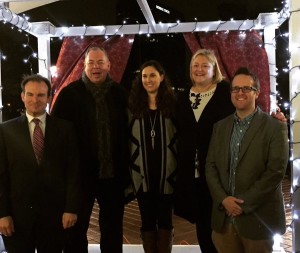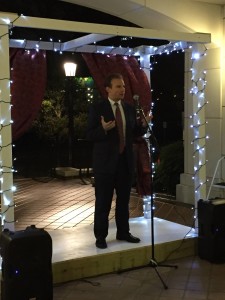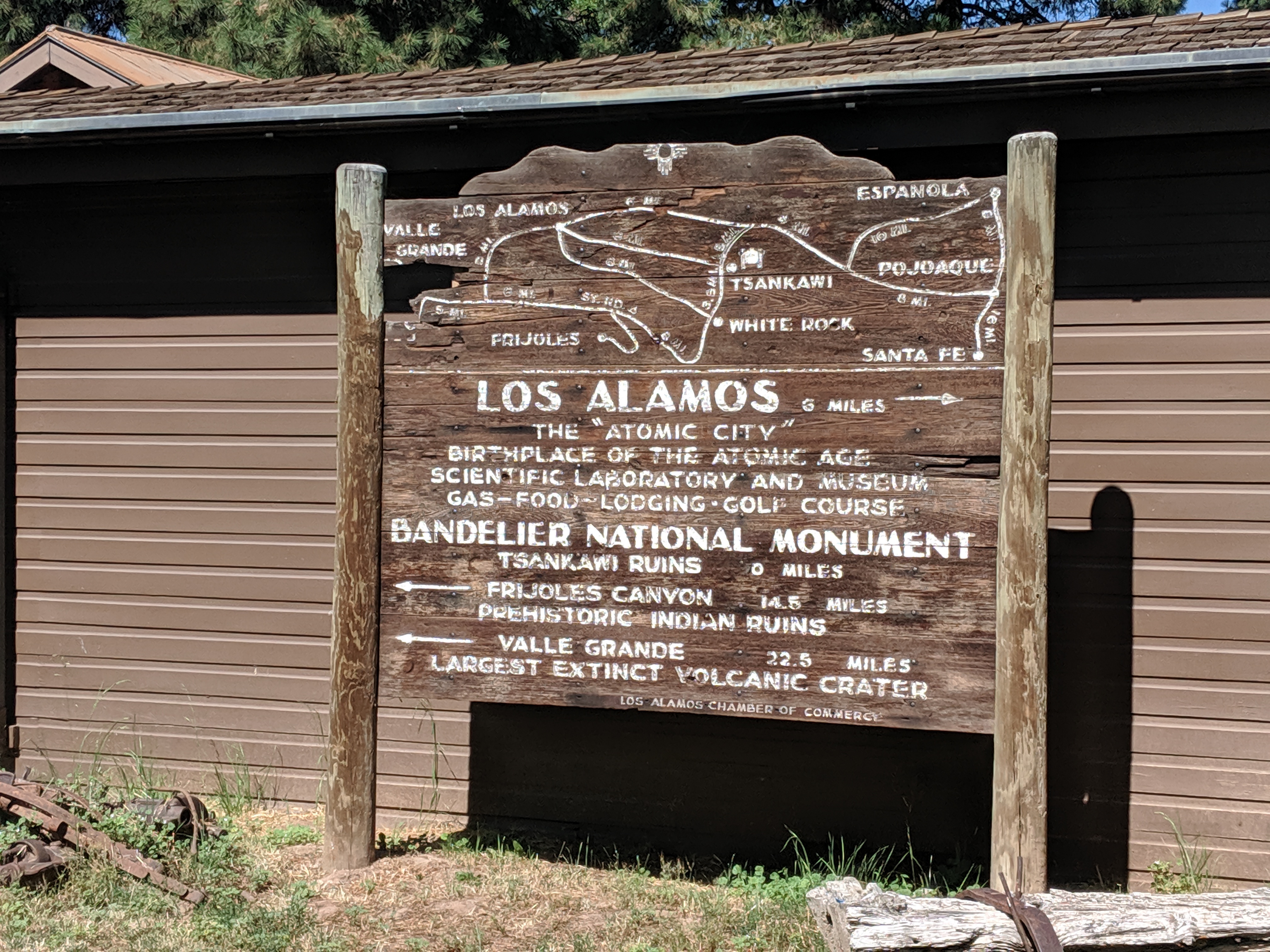
The following is the underlying text I wrote as the basis for a talk at the TEDxSMU-sponsored event, “Loyd on the Lawn.” It was held at Loyd Residential Commons at SMU, where I was invited to give a short (~10-minute) talk last Sunday night. Enjoy!
Introduction – what I do and tour guide/discovery

I am a Professor of Physics here at SMU. While I love teaching physics, my primary activity is research. What do I study? I study the building blocks of the cosmos, the forces that bind them together into the cosmos, and how the cosmos has evolved from the first moments of its existence and through the vast 13.7 billion years since its birth. I am humbled and honored to be able to do what I do. When I was a graduate student I was also a part-time tour guide at a National Laboratory. As I closed my tours, I used to tell my tour groups that I would be pleased to experience one single act of major discovery before I die.
Two major discoveries – Higgs… but first, 2008
Since those idealistic days, I have had the humbling experience of being involved in two major discoveries. The first happened in 2008 and the second in 2013. The second one is the one that gets all the headlines; a new particle was discovered in 2012 at the CERN Laboratory in Geneva, Switzerland. It was believed to be the Higgs Boson, the long-sought and elusive subatomic particle whose existence was predicted in 1964 and helps explain the origin of mass in the universe. In 2013, I was part of a large team of physicists racing to measure its properties, and indeed we confirmed this particle was THE Higgs Boson. This discovery helped earn some of the 1964 proponents of the particle the 2013 Nobel Prize in Physics.
However, I’d like to share with you today the 2008 discovery, which was a learning experience for me as a young scientist. It was a discovery that taught me about being prepared, about focusing down and going deep into a subject, and about the role that failure often plays in the act of discovery.
2005 – Dark Matter and The Method
The story begins in 2005. At the time, I was a post-doctoral researcher at the Massachusetts Institute of Technology. I had become obsessed with the idea of searching for Dark Matter using earth-based subatomic particle colliders. Dark matter makes up 25% of the cosmos, but we have no idea what makes up Dark Matter. A good friend of mine had been working with some colleagues on applying an old idea in a new way: to look for very low-mass dark matter particles. I fell in love with this idea – let’s just call it “The Method”. It’s not important to know what The Method is; it’s only important to know that as an experimental scientist I am ALWAYS obsessed with method – the elegance of the technique, its problems and limitations, and how you quantify those things. I was obsessed with The Method, and I set out to apply it to the data I had at the time on my experiment.
BaBar, Wrong Data, Side Project at MIT
I was working on a 500-collaborator project called “BaBar” at the time (like the childrens storybook elephant!), one of two similar competing experiments. BaBar was focused on physics that really didn’t have anything to do with searching for low-mass dark matter. As a result, I didn’t quite have the best data for the job, but that didn’t matter; nobody else was working on this idea at the time and data is data, so I pursued it. I did so as a side-project to my main work at MIT, and my boss was open-minded enough to let me do it as long as I didn’t drop my main work.
2006 – Good Ideas are Public; Crushed by the Competition
But, of course, a good idea is always shared publicly in science… and our competitor experiment learned about The Method and liked it just as much as I did. Unlike my own experiment, our competitors actually scheduled a dedicated three-day exercise to collect data specifically designed to take the best advantage of The Method. They very quickly analyzed that data and by December of 2006 they had produced a journal publication with a result that was over 10 times better than I could ever hope to achieve at the time. I was professionally crushed.
2007 – My Very Bad Year
This kicked off what I like to call my “very bad year.” 2007 was awful. The money ran out to support me at MIT about a third of the way through the year, and I was forced to do a very short-fuse search for a second physics research job. I was very lucky to be hired by The Ohio State University in July of 2007. Then, my mother suffered a heart attack in August of 2007. To cap it off, the U.S. Congress failed to pass individual spending bills and on December 17 of that year they passed what is called an “Omnibus Bill” where they roll all federal spending bills into one, with little oversight or review, and pass it all at once very quickly. This resulted in major spending cuts to my field, which is 90% supported by the Department of Energy. As a result, my experiment was canceled about 8 months ahead of schedule. Threatened with rapid closure, we were told: come up with new things to do with only few weeks of operation, or be shutdown immediately.
2007 was a very bad year. In every aspect of my life, there was tremendous failure. My competition’s success reduced my research to a seemingly pointless exercise. I lost my position at MIT, because there was no more money, and had to scramble to find another. My mother suffered a heart attack. My experiment was canceled with little or no warning.
2008 – Opportunity, Awesome People, Sense of Family
From this bad year emerged 2008. Indeed, my experiment did make a pitch to do a very short amount of special data-taking that would allow us to do several things, including searches for low-mass dark matter and for a state of normal matter predicted in 1977 that had eluded detection for 30 years. Both searches would use a variation on The Method. The Department of Energy, even with their reduced budget, agreed to support these activities. I was made a co-leader of the effort to collect this data and secure these physics goals. This was my first major leadership activity with such big things at stake, and I got to work with awesome people. Things were so crazy, we even took data over Christmas. This was the first time my experiment had ever done that. My wife and I brought Christmas Eve dinner to the young scientists taking night shift, running the experiment 24 hours a day. There was a sense of family and adventure and devotion to science, even in the wake of having our funding cut.
More time for the data; the discovery
We took the data. At first, we were given a month to do it. Then two. In the end, the Department of Energy supported us to operate for 3 months, taking more of this special data than anyone had ever taken before… including our competitor experiment. We raced to analyze it, searching both for Dark Matter and for that elusive state of matter predicted in 1977. In the end, we didn’t find low-mass dark matter… though we were 10-times more sensitive to it than any previous experiment, including our competitors. But we DID discover that elusive state of matter. It popped up out of the data set, trying at first to hide in a huge pile of noise but teased out by a variation on The Method. We had discovered something long-sought but never seen before. It was a euphoric moment for our experiment, and especially for the team of young researchers involved in the project (nearly all of us were under 35 at the time).
Failure sucks, but here is what it taught me
Failure sucks. But the truth is, if you’re not failing you’re not trying to be good at what you love. I love being a good son, but that means my mother’s heart attack was an icepick to my own heart. She survived it, and in the long months that followed she recovered, changed her diet, lost a lot of weight, and came out better than she had been before. It motivated my family to be healthier; I started regular exercise, eventually learned to manage my calories using data, lost 50 lbs, and using data and commitment I have kept that weight off. I loved being a researcher at MIT, which means when the money ran out it hurt a lot to have to drop everything I was doing and look for a new job. But that also worked out – my mentors at The Ohio State University gave me total research freedom, and that let me become a leader later. I loved the BaBar Experiment, and its early cancellation hurt; but that allowed us to try something new, and it succeeded. I loved The Method, and it wounded me when my competition crushed me with it in 2006. But that set the stage for a hunger to do more, and do it better, in 2008. All those failures were lessons. I was always devoted to my field… but I needed to fail to understand just what was needed to actually succeed, and to do so spectacularly.
Conclusion – risk leads to failure, failure is a lesson
So I would argue that failure is essential to discovery. An act of discovery first requires commitment to excellence – you have to be smart enough and skilled enough to pursue a goal and know when you’ve achieved it. In science, you begin by learning the basics in college but mastery comes with practice in the years that follow. Still, that’s not enough. Just being smart enough or good enough is not enough – you have to take risks. Failure is a natural outcome of risk. So if you’re risking enough, you’ll fail a lot. But every failure is a lesson. Learn the lesson. And then try again. Because there are many questions to be answered, and a discovery is just around the corner if you’re willing to risk failure.



